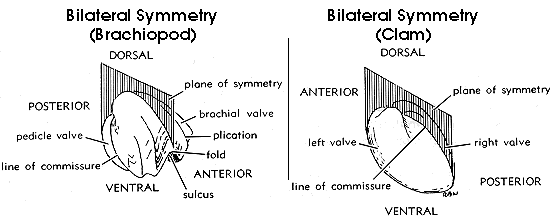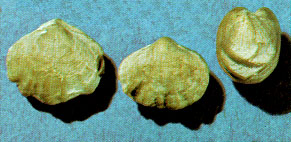Ancient Life in Kansas Rocks, part 17 of 27
![]()
Nuculopsis 1a-c in the photograph) is a small, shallow-water borrowing clam. Not yet extinct, it lives in muddy sediment and as a fossil it is therefore commonly found in shale. (Photograph is slightly enlarged)

The line drawing below is helpful in illustrating the differences in symmetry between pelecypods and brachiopods. Each valve of Nuculopsis (right drawing, "Bilateral symmetry (clam)") is nearly a mirror image of the other, so that the plane of symmetry lies along the line at which the valves join, called the line of commissure. This is true of most clams. Brachiopods are quite different. Inasmuch as their valves are seldom similar, the plane of symmetry that divides the animal into mirror-image halves passes vertically down the middle of each valve (left drawing, "Bilateral symmetry (brachiopod)"), and is perpendicular to the line along which the valves join.

Enteletes shown below, is an orthid brachiopod, demonstrated this difference in symmetry. Enteletes was described earlier in the Orthid Brachiopods section. (Nuculopsis, Lane Shale, Upper Pennsylvanian; Enteletes, Plattsburg Limestone, Upper Pennsylvanian)

Previous Page--Cephalopods ||
Next Page--Pearl Clams, Oysters, Scallops
KGS Home Page ||
Education Index Page
Kansas Geological Survey
Placed online Feb. 1997, updated Feb. 26, 2008
URL = "http://www.kgs.ku.edu/Publications/ancient/f17_nucu.html"
Send comments and/or suggestions to webadmin@kgs.ku.edu